Smallmouth bass, despite their relatively smaller size, are the absolute favorite species of many general tackle and fly anglers alike. Smallmouth are an absolutely incredible species of bass to pursue with a fly rod. The environment they are found in, their aggressive and savage nature, and their tough attitude during the fight all make fly fishing for smallmouth bass a must for every fly angler. There is no way to cover all aspects of fly fishing for smallmouth bass in an article, but the information below will give you a solid grounding in pursuing smallmouth with a fly.
SMALLMOUTH FLIES
BIG RIVER SMALLMOUTH
SMALLMOUTH BASS NATURE
Smallmouth bass are a very curious species of bass. They will follow their schoolmates around when hooked, giving you the opportunity to cast a fly to the friend. They will also investigate underwater clicking noises from far away. This curiosity makes them particularly susceptible to many different fly actions and patterns.
Smallmouth are a more social species than, say, the largemouth bass but aren’t necessarily as likely to be in a school as a striped bass or a white bass. This of course depends on the environment, but many fish can be caught out of the same place more often than not.
Smallmouth bass are extremely voracious. As with all species of fish, smallmouth bass are cold-blooded, so their activity level can vary tremendously, but when they are at their peak, there are few species of fish that can match the voraciousness of a smallmouth.
I once caught a 13” smallmouth on a 7” fly. That, in itself, was not surprising. The water snake in the fish’s mouth, on the other hand, really demonstrated how aggressive and gluttonous these fish are. Never underestimate a smallmouth bass when it comes to what they’re willing to eat.
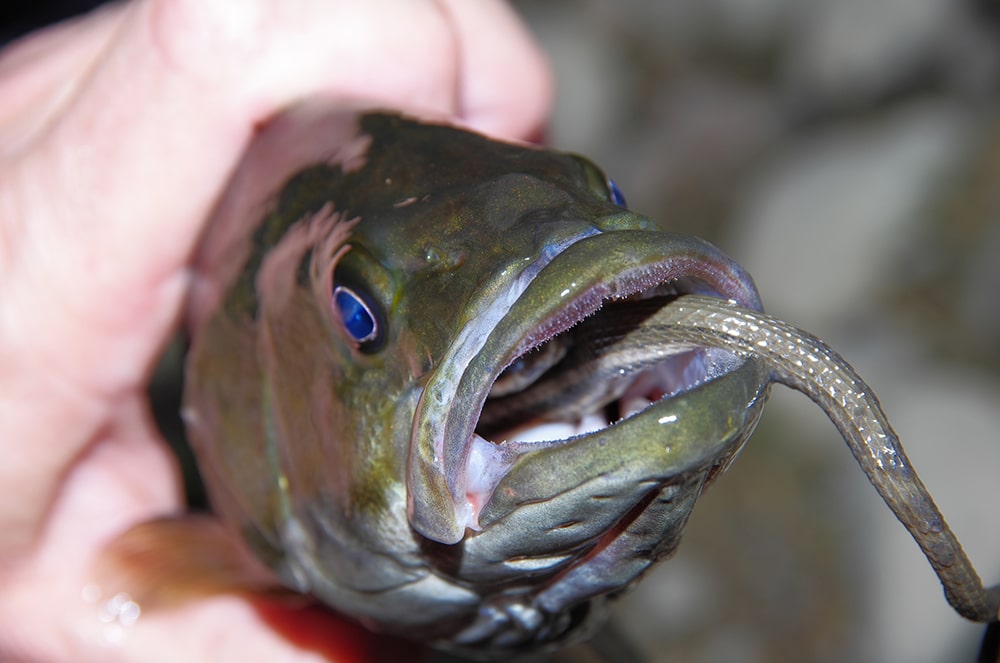
Smallmouth bass are versatile. They can eat at every level of the water column, and they eat aggressively at each of these levels. They are found in a huge variety of habitats, requiring more oxygen than a largemouth bass, which explains why they are so at home in rivers. So, no matter where you’re at, you’ve probably got smallmouth around you that will gladly munch on a fly.
SMALLMOUTH BASS BIOLOGY
SMALLMOUTH BASS LIFECYCLE
Smallmouth bass are spring spawners. Adult males choose nesting sites in rocky substrate and prepare the nest for the females. Females then lay eggs and eventually head to deeper water to recuperate. The male fertilizes the eggs and protects the eggs and fries until they grow enough to get to the shallows, where they’ll school up with other smallmouth juveniles. The fish grow in the nursery parts of the body of water and eventually move out to the main body of water.
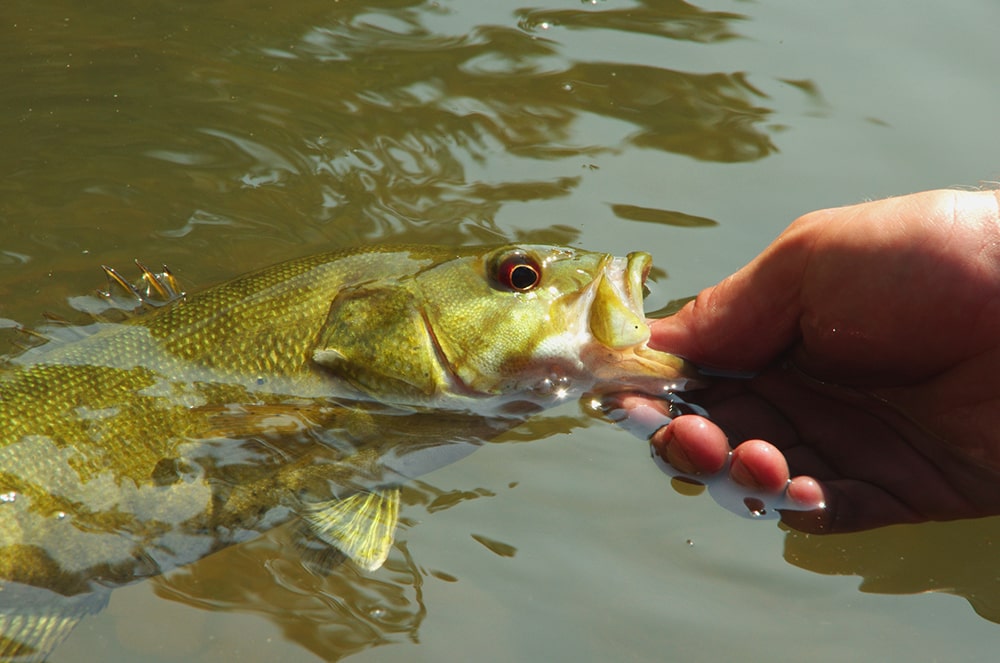
SMALLMOUTH BASS MOVEMENT
Smallmouth can be highly migratory both on a seasonal and daily basis. This depends on the fish’s environment though as some river fish will stay in basically the same place at times. Common migrations of smallmouth bass include fish out of lakes or larger rivers into smaller rivers. This could be in the spring for the spawn only, or it could be for the entire warm season.
Smallmouth will also migrate seasonally within a river or a lake, based on oxygen and food needs. Smallmouth need more oxygen the hotter the water gets. Hot water causes them to go deeper (colder) in lakes and into current in rivers because the hotter the water is, the less dissolved oxygen it has.
Smallmouth bass will also move on a daily basis, depending on the water temperature and food source. Just like a trout will move from a deep run to a shallow riffle during a mayfly hatch, smallmouth will follow baitfish into the shallows or into open water if the baitfish are an open-water species. Schools of juvenile perch and warming water may draw them into the shallows in the later morning in the spring. There are many different scenarios that might cause smallmouth to migrate throughout the day, so experiment every time you hit the water.
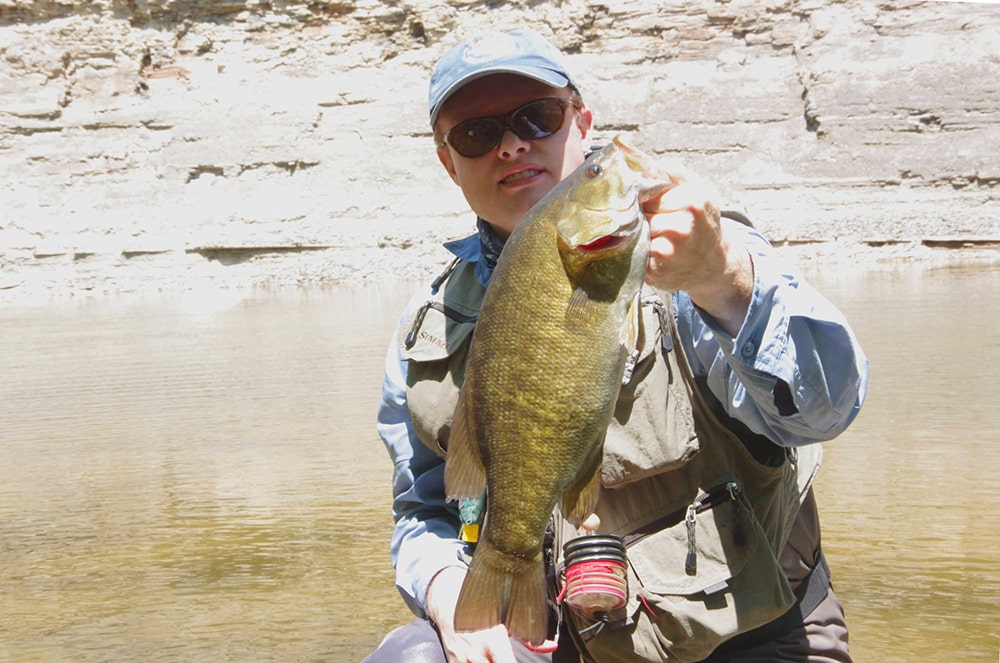
SMALLMOUTH BASS FEEDING HABITS
Smallmouth bass are highly adaptable and will eat virtually anything. They use a feeding mechanism that has been termed “ram-suction.” This essentially means that smallmouth can feed by using suction to slurp something off the bottom into their mouth, or they can move rapidly towards a prey item and “ram” it with an open mouth. In this light, smallmouth bass are highly versatile feeders, and this is why they have such a varied carnivorous diet and why smallmouth will eat at every level of the water column as easily as the next.
Smallmouth do prefer to have some sort of cover or edge to ambush their prey. In this respect, you can pattern smallmouth on a given day of fishing. For example, they might be hanging out around the biggest clumps of rocks of a certain size, crushing open-water baitfish against the surface, or hanging out along weed beds in the summer.
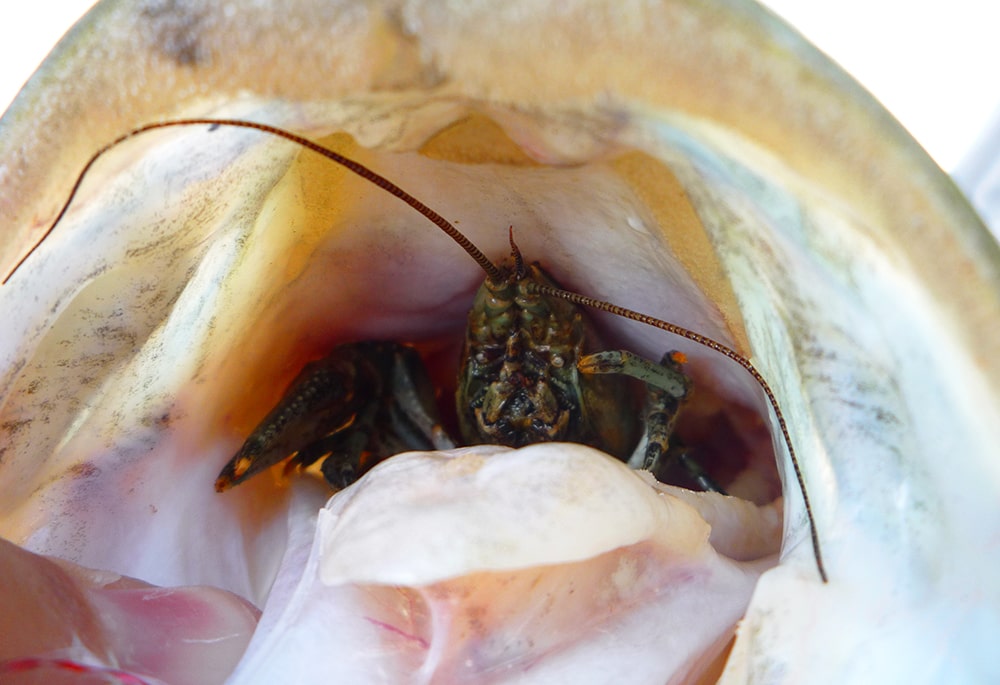
SMALLMOUTH BASS SEASONS
Smallmouth bass, like all fish, have a specific calendar in which they display predictable habits. Some of these movements are related to mating, some to food, and others to oxygen/temperature. There are other reasons they move from one place to the next, but these three are the main driving factors behind their activity throughout the year.
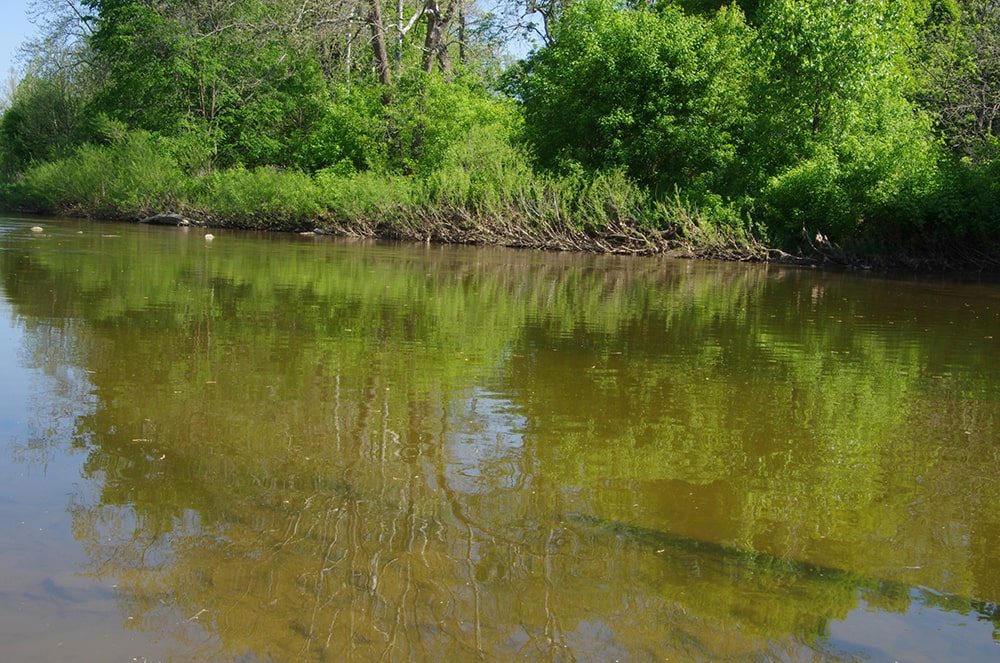
PRESPAWN
Smallmouth bass move from their wintering habitats as they prepare for their spawn. The exact month of this “prespawn” activity varies from Texas to Ontario because each state varies in its latitude and temperatures. Smallmouth bass are normally in their prespawn preparations from about 45 to 58 degrees.
Because of the tremendous energy strain that the spawn requires, they try to pack on the pounds like a bear after hibernation. These fish are some of the biggest fish you will catch all year as they resemble footballs, stuffed full of crayfish, baitfish, and whatever else they can get their mouth on.
Like essentially all species of fish, smallmouth prefer a certain habitat to carry out their spawning rituals. They will move to these shallower spawning flats and smaller rivers to feed before they begin to spawn. If you can find smaller rivers coming out of large bodies of water or shallow flats adjacent to the smallmouths’ wintering areas, you’ll find smallmouth bass that are willing to smack your flies.
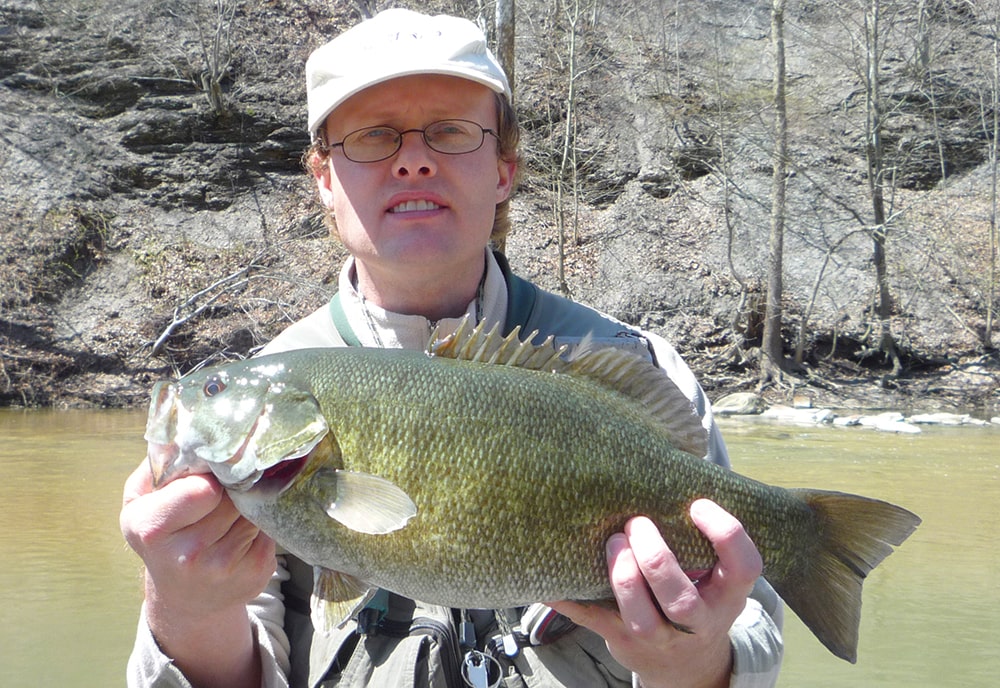
SPAWN
Once the water temperature reaches between around 59 to 64 degrees, the smallmouth will begin to hit the spawn hard. Males begin to build nests, which they will guard before and after eggs are laid and the little smallmouth fry are present.
Smallmouth bass can be caught on beds fairly easily, and depending on your location (higher or lower latitude), this may affect survival rates and the overall health of the fishery. Smallmouth bass in the northern latitudes (in small to medium fisheries) normally have shorter spawning periods, and therefore everything is condensed. Some states will not open the season until after the spawn. Keep in mind that you may have many phases of the spawn in different bodies of water and even in different sections of a river or lake.
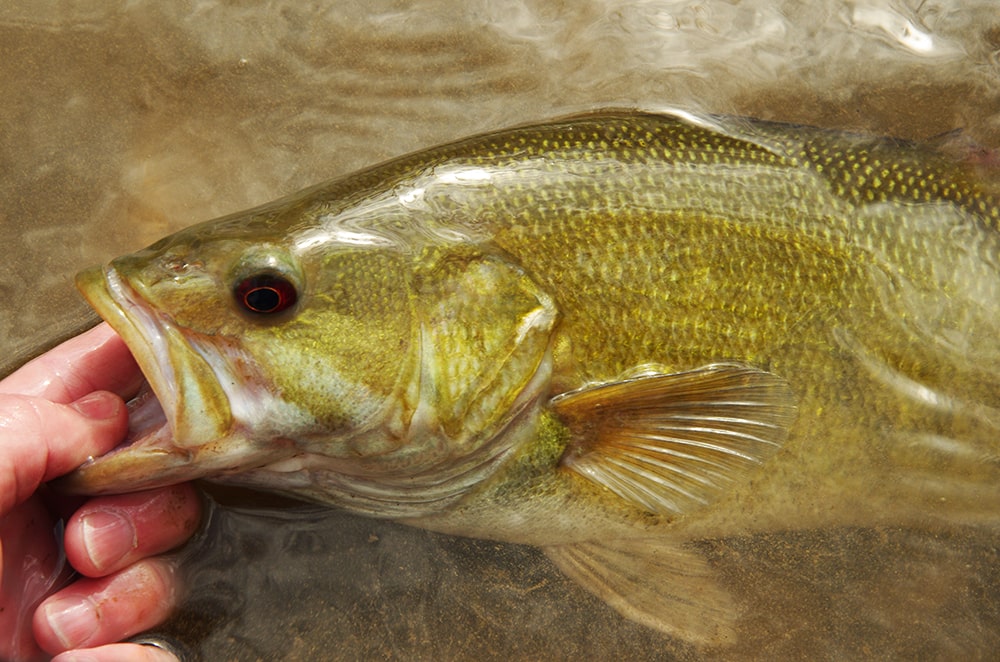
POST-SPAWN
After the spawn when the water temp is normally above 65, the fish may have a period where they are recuperating in deeper water. Depending on what stage they’re at, they may look skinny and “spawned out.” Smallmouth in this phase can be finicky, but once they begin to come out of their resting period, they will be voracious once again.
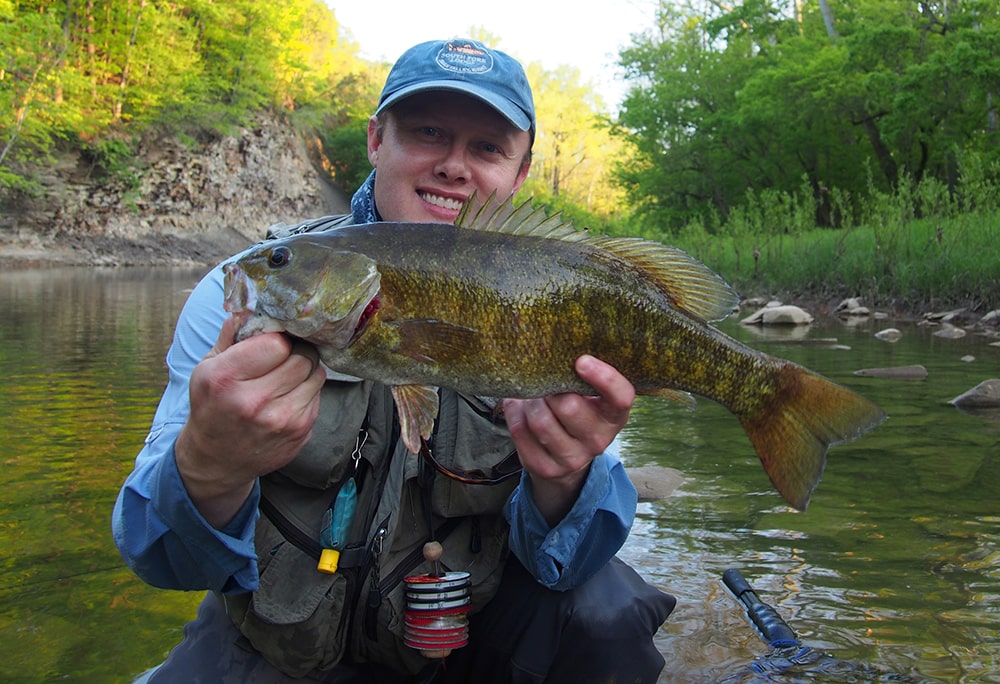
photo: Jeff Liskay
SUMMER
When water temperatures are between around 68 to 70 plus, smallmouth must feed heavily to survive. If the water gets too hot, they may sulk in the depths and make periodic movements into shallower feeding areas. Many rivers that had tons of fish during the spawn may lack these same fish in the summer, fall, and winter. However, high muddy rivers will push them back into these clearer, fast-flowing rivers for oxygen and relief from the constant sediment and blasting current.
In some river systems, smallmouth will push into the river through the whole summer and then return in the late fall. Other rivers that have obstacles to impede migration or larger rivers in general will keep larger smallmouth around throughout the seasons.
You can fish faster in general during this summer phase, and topwater fishing is the norm. Smallmouth will be attracted to current in rivers particularly in the hottest times of the year as in early fall in most places.
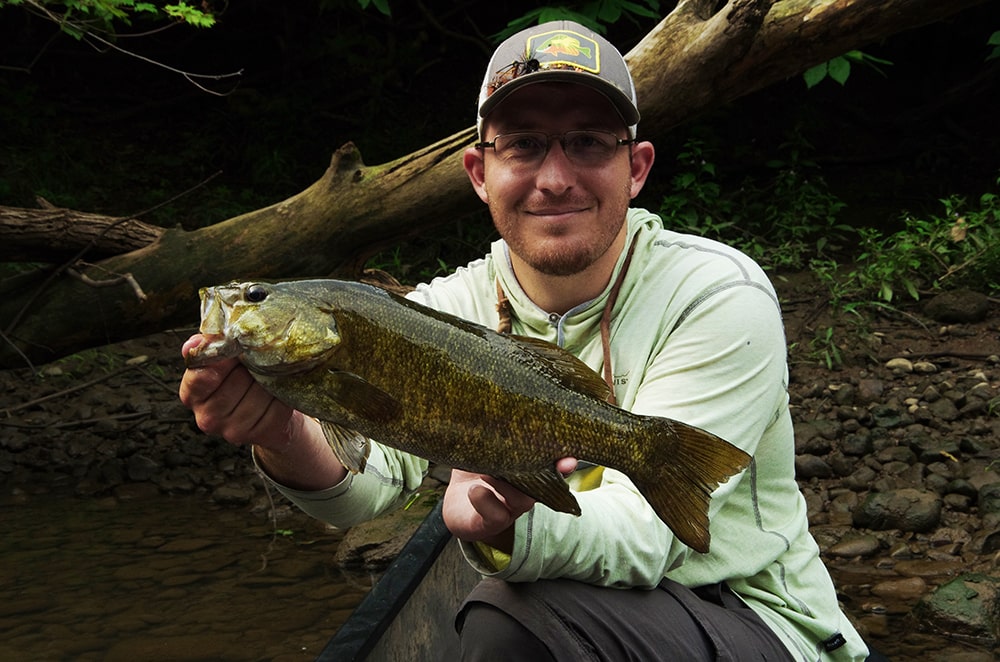
FALL
As the water temps dip back into the mid-sixties, from about 65 to 50, smallmouth put on the feedbag. They know that winter will be coming and that they have a limited window to take advantage of the food sources available to them.
There is a period where the water dips and smallmouth take a few weeks to adjust, so expect good fishing on both sides of this dip in water temperature. Topwater fishing slows down for the most part towards the end of this period.
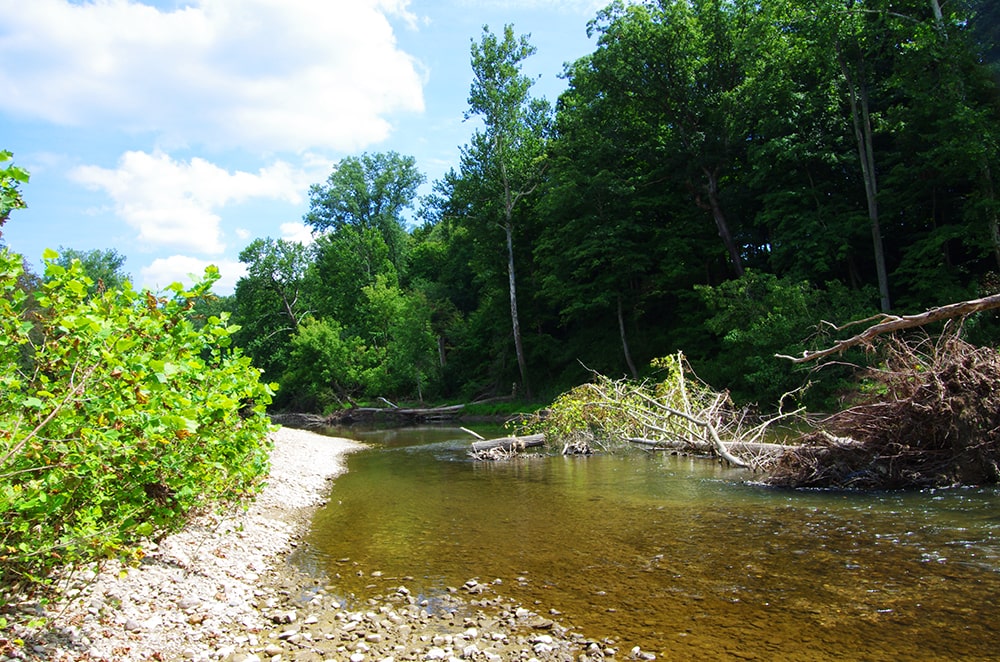
WINTER
Around the upper forties all the way through ice over, smallmouth will transition to their wintering areas. This is deeper water that is actually at times somewhat warmer than the surface water. They will also leave smaller rivers if the rivers empty into larger rivers or lakes/reservoirs. If they are more or less stuck in a river, they will locate deeper sections of the river for their wintering period. Once the water begins to warm again in the spring, they will start the process over again.
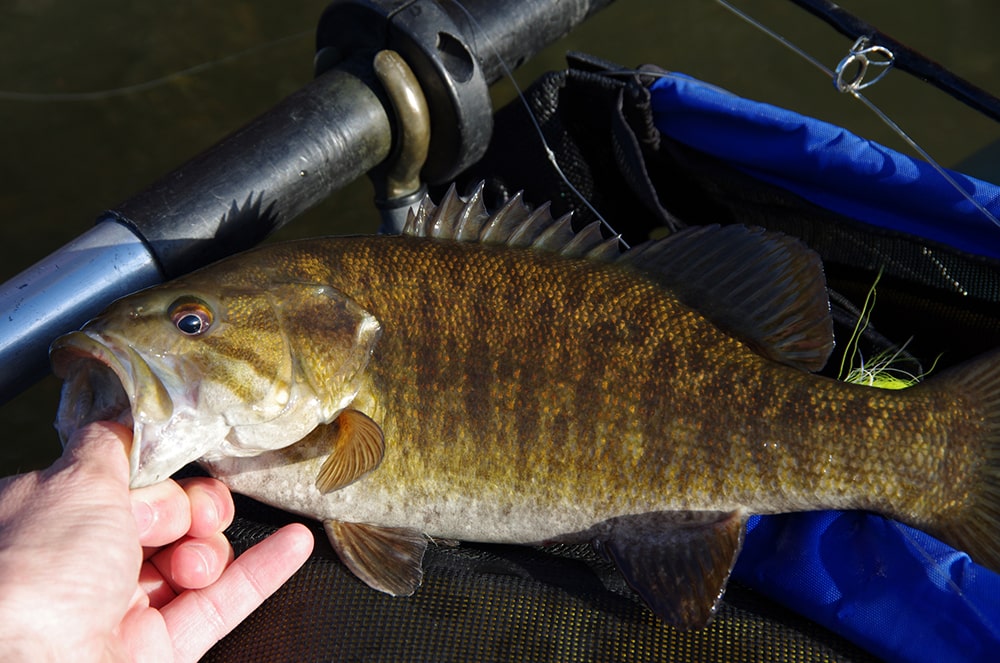
SMALLMOUTH BASS FEEDING HABITS IN-DEPTH
Smallmouth bass have one of the most varied carnivorous diets of any freshwater fish. They will eat hellgrammites, mayflies, cicadas, grasshoppers; frogs, salamanders, snakes; crayfish, gobbies, sculpin, darters; ciscos, alewives, shad, shiners, perch, trout; chubs, suckers, bluegill, and dace. This is just a sampling of the food items, so make sure to learn about your particular body of water.
Because smallmouth bass have such a diverse diet, you can fish to them with flies in almost any way you prefer. A good rule of thumb is to assess the variety a smallmouth bass has within a body of water that you fish.
For example, let’s say that you fish the Great Lakes. Gobies will condition fish to feed near the bottom on goby-sized flies consistently. On the other hand, you may fish a river in the Midwest that has frogs, crayfish, chubs, suckers, etc. In this case, the water temperature will dictate how you catch these fish and on what flies, not necessarily the food item. In other words, this isn’t a match-the-hatch situation.
Smallmouth bass are hugely opportunistic. Even if they’ve been feeding on crayfish until their stomach is on the verge of exploding, they will still take a popper or a large streamer. If smallmouth are in an environment where they see a huge variety of prey items, they will respond to triggers like few fish will. Let the water temperature and oxygen level be your first gauge on how you want to fish for smallmouth, and then watch how the fish are responding to your presentation. Adjust from here.
Finally, smallmouth bass love to feed on top. In fact, you will catch huge smallmouth on top consistently when the water temperature is high enough. This could be anywhere from 50 and above, depending on the body of water. Because they like to have edges to ambush prey, the surface is one edge that they use often. Take advantage of this, and you’ll see some big fish on top.
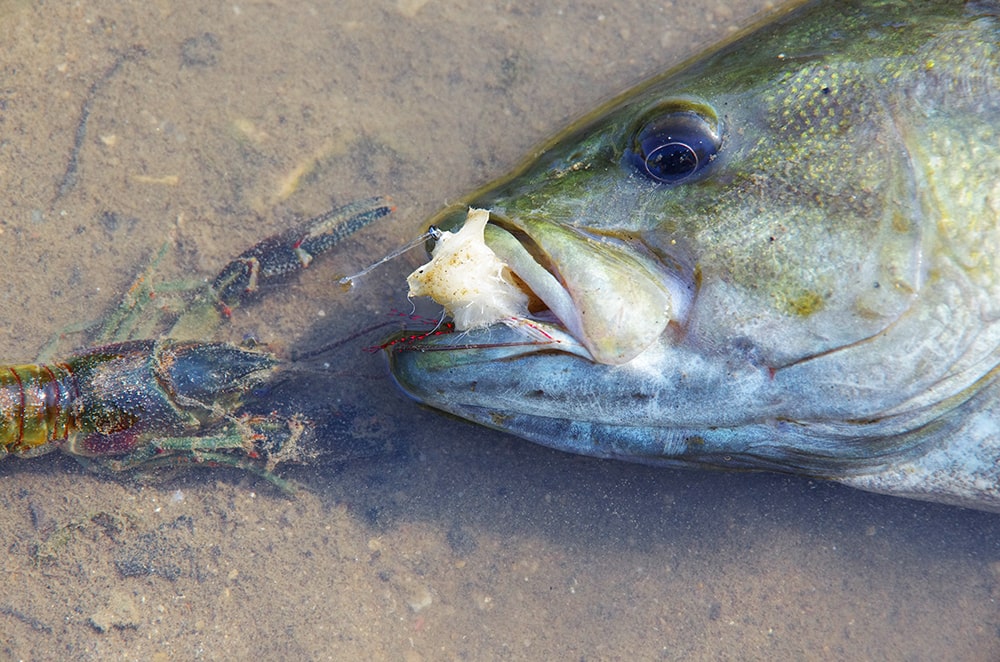
SMALLMOUTH BASS ENVIRONMENTS
Smallmouth are found in many different environments. They prefer to have water temperatures that don’t get too high, say 80 and above, and they love current. For this reason, you don’t really find them in small, land-locked ponds like you will largemouth and bluegill. The three main types of water you’ll find smallmouth in are reservoirs, natural lakes, and rivers.
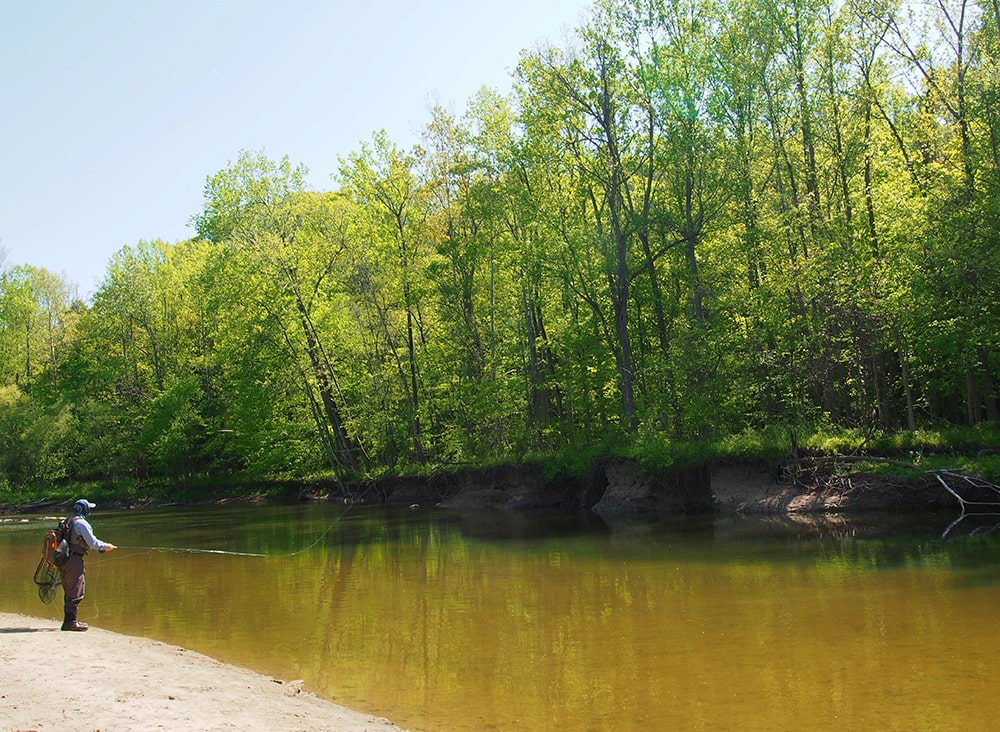
photo: Jeff Liskay
SMALLMOUTH BASS STRUCTURE
Structure is the major geological formation of the lake or river that smallmouth inhabit. Each body of water mirrors the geography around the body of water. If it’s steep on the banks, this body of water probably has steep drop-offs underneath the water. If you have electronics, you’ll be able to tell what the body of water looks like underneath. Otherwise, let the surrounding geography be your guide.
Smallmouth love structural variance. For example, drop-offs, slopes, flats, points, islands, humps, and really anything else they can find. This variance allows them to use the geography to ambush prey items. Like with trout, they will use this structure depending on what they are doing, like spawning, feeding, resting, hiding, etc. Concentrate on structure that matches the instincts of smallmouth bass for the time of year and daily changes to the smallmouth’s environment.
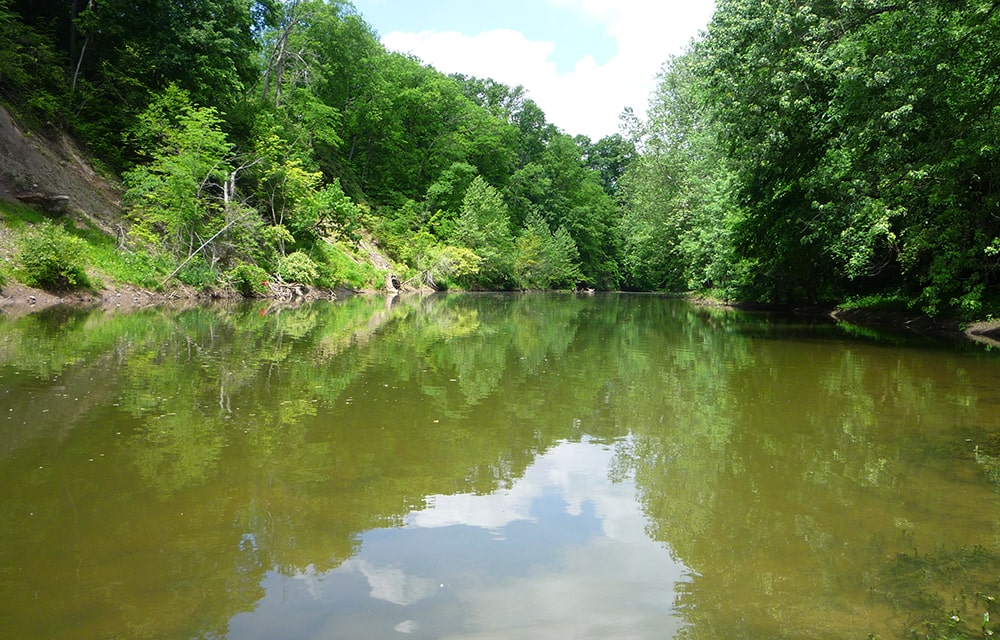
SMALLMOUTH BASS COVER
Cover is anything that covers the structure. Examples are rocks, wood, weeds, sand, brush, and even shadow. Cover can create structure of sorts. For example, weeds can create vast jungles that smallmouth can use to ambush prey items even if the underlying structure is uniform, like on a flat. However, when you can find good structure and good cover together, you normally have something special.
Cover in rivers is often the most important feature because it creates current breaks, ambush points, and protection from predators all in one place. The riverbank and the surface are also two great edges that smallmouth bass will use. That’s why pounding the banks with smallmouth flies is so common.
Cover transitions are incredibly productive spots to focus on. For example, you could have a river with a large section of shade. I’ve found schools of fish in these shadows.
Another example would be on the Great Lakes when you have sand to rock patches. Smallmouth will school up on these patches. Pay attention to differences in cover!
So, once you find the general area and structure that the smallmouth are using, then you concentrate on cover. From here, you can refine presentation.
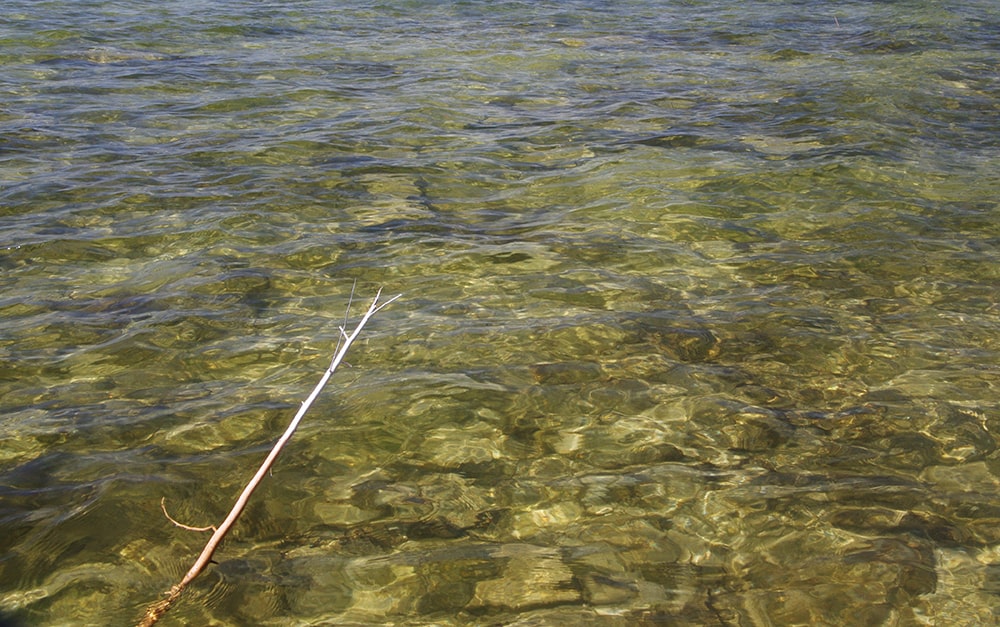
SMALLMOUTH BASS FLIES
Smallmouth flies are some of the most innovative flies that we tie. Books have been devoted to smallmouth bass flies, and so it’s very hard to do these flies justice in a short section. To get an in-depth view, see this article on smallmouth bass flies. This will give you a comprehensive crash course on what flies are out there and how you should select them.
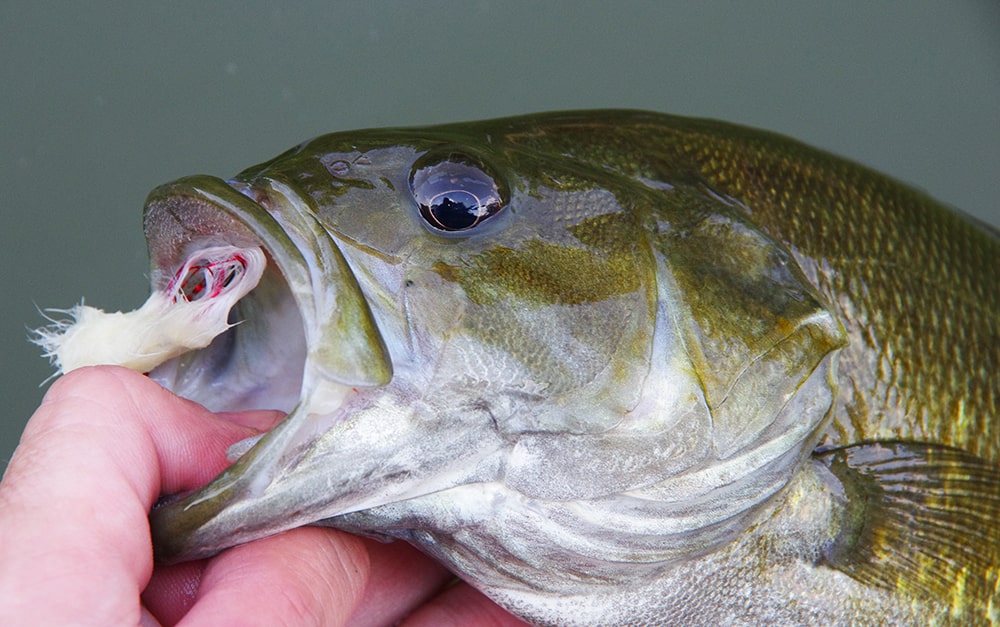
SMALLMOUTH BASS FLY FISHING EQUIPMENT
SMALLMOUTH BASS WATERCRAFT
The first piece of equipment that you should consider is some sort of watercraft. There are many smaller rivers where you can still catch lots of smallmouth on the fly, but you are somewhat limited if you are only wading. Your ability to catch more and bigger smallmouth bass on the fly will increase dramatically if you use some sort of watercraft.
I have fly fished for smallies, using at least 5 different types of watercraft, which you can use as well: kayaks, pontoon boats, canoes, drift boats, and bass boats. Each one offers you benefits and limitations. It depends on whether you’re fly fishing for smallmouth bass on a lake or on a river and whether you’re fishing alone or with others.
Kayaks and pontoon boats are best if you’re fishing alone on smaller bodies of water, particularly rivers. Both will still work on some fairly large waters. Canoes and drift boats are best with multiple anglers. Both will also work on stillwaters. Finally, a bass boat, or any boat, is the best of both worlds on lakes, reservoirs, and larger rivers. Whatever you decide, try to get some sort of watercraft to fly fish your waters.
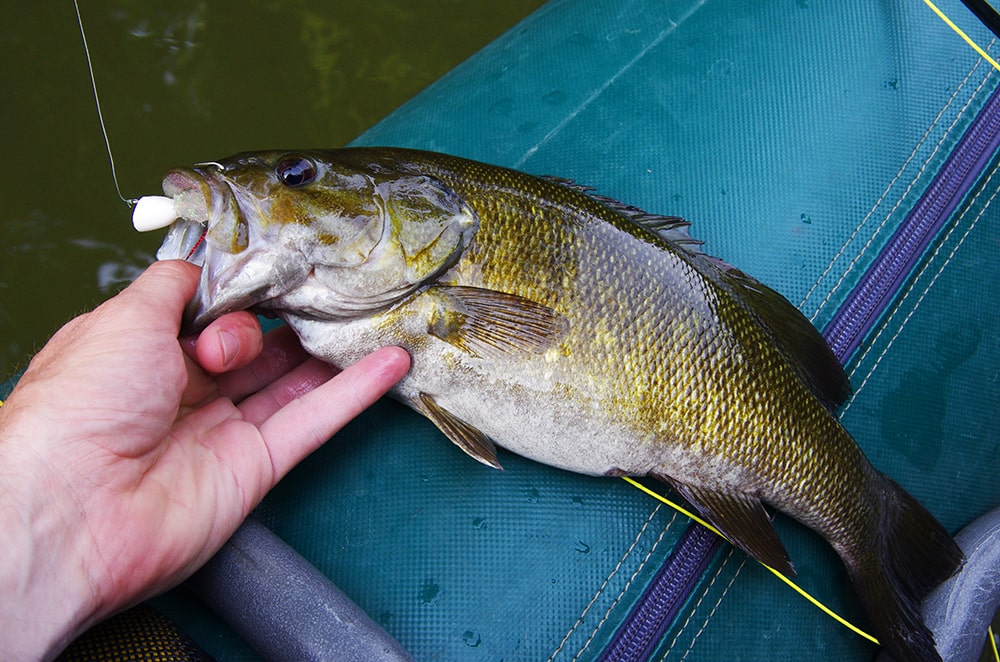
SMALLMOUTH BASS FLY REELS
Reels for smallmouth are not as important as other pieces of gear since you are almost always stripping the smallmouth in. You still might want to get a reel that is well-made so that you don’t break it or gum it up on the water. I prefer a large arbor fly reel for less line coils and the comfort of getting line on the reel fast. Just know that you’re not going to have smallmouth making huge runs of line. I know of no angler anywhere in the world that has gone to their backing while fighting a smallmouth bass on a fly rod. Rods and specifically lines are more important.
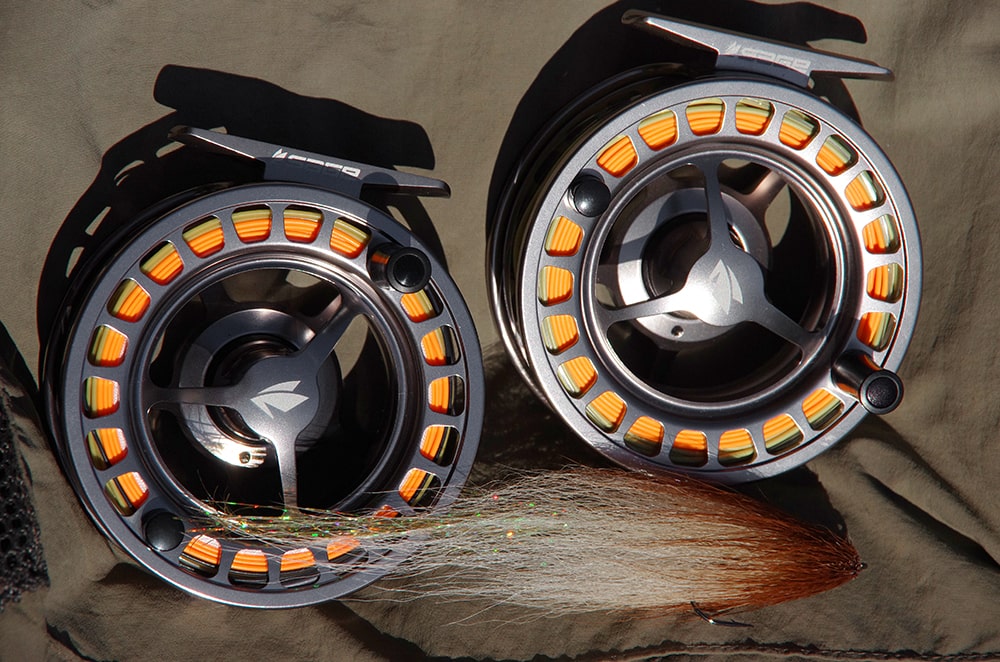
SMALLMOUTH BASS FLY RODS
Because smallmouth inhabit a ton of different habitats, you can use many different sizes of rods. The best fly rods for smallmouth are 6 – 8 weights. Choose your rod based on the consistent distances you’ll be casting, size of flies you’ll be throwing, and depth you’ll be fishing. Small rivers or bank banging are just right for 6 weights. Bigger flies and longer casts are great with a 7 weight. The biggest flies, heaviest sink tips, and longest casts are perfect for an 8 weight.
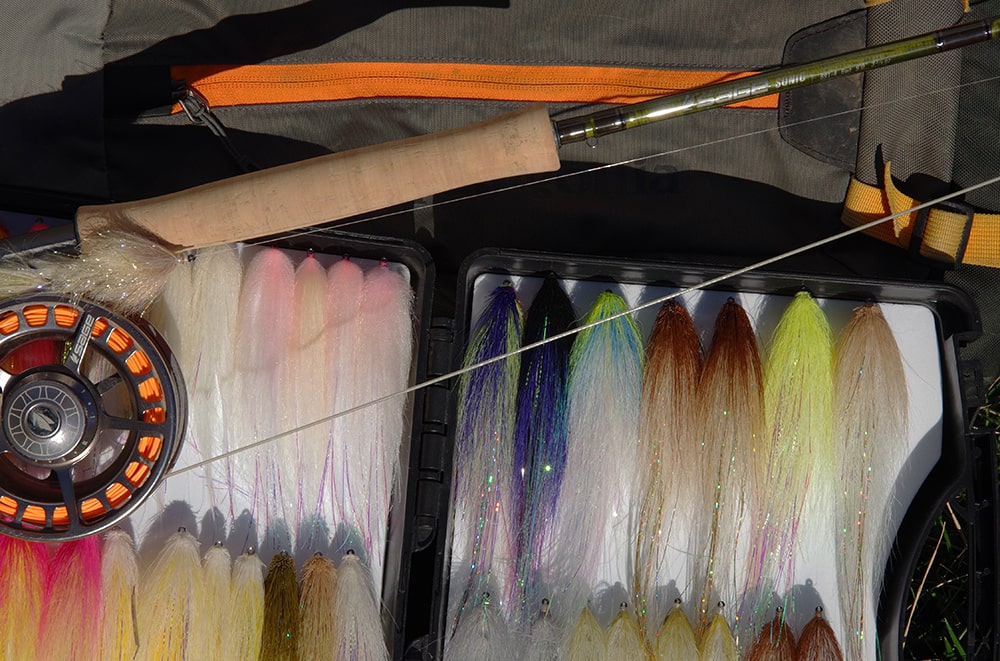
SMALLMOUTH BASS FLY LINES
Fly lines are hugely important for smallmouth bass. Spend the money on a good line.
Smallmouth fly anglers use 3 types of lines consistently: floating, sink tip, and full sinking lines.
You can use a floating line for all topwater fishing, divers, and even with weighted flies. I like Rio’s InTouch Big Nasty floating line for smallmouth bass.
Sink tips are a must in your arsenal specifically for jerkbait style flies that need a pause. On rivers, use mostly the intermediate sink tip and perhaps a type iii sink tip to get down a bit more or with more buoyant flies. On bigger rivers and lakes/reservoirs, as in the Western United States, you can use heavy sink tips and even shooting heads if you need to cover water at depth. I like Rio’s InTouch Big Nasty sink-tip fly lines for smallmouth bass in most scenarios.
Full sinking lines are less commonly used, but I love a full sinking clear or clear-camo intermediate for smallmouth. If you’ve got some suspended fish in the depths, full sinking lines are absolutely an option. If you have a bunch of full-sinking fly lines for trout, you can use these on smallmouth. Even on deeper Wester reservoirs, I still prefer a clear intermediate, sink-tips, and a floater, rather than ultra fast sinking lines.
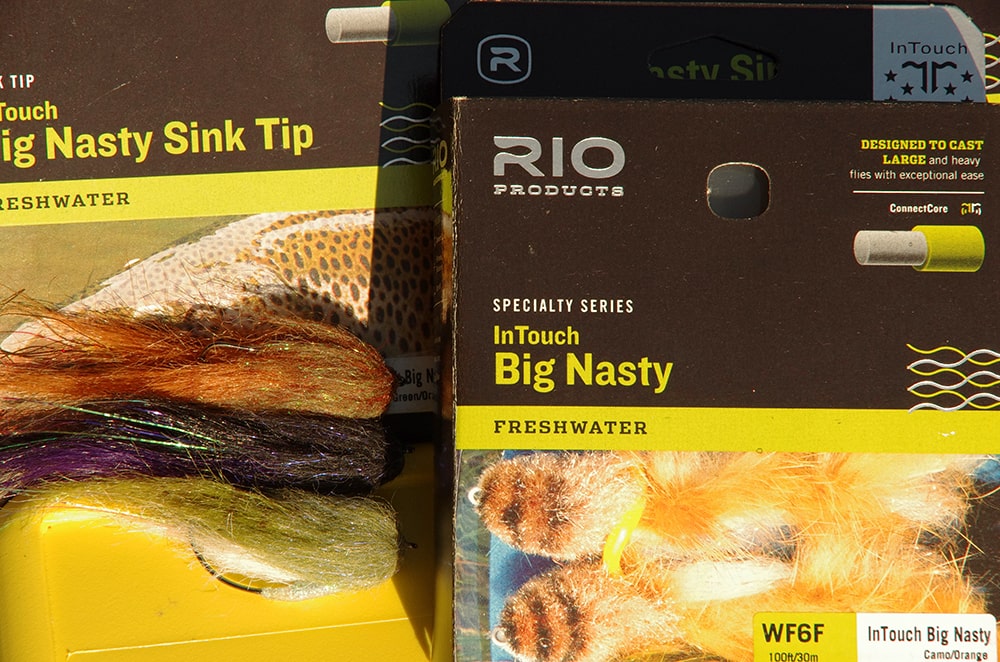
SMALLMOUTH BASS TIPPETS/LEADERS
Most smallmouth bass leaders shouldn’t be very complicated. You can fish a standard tapered leader with a floating line, ranging from 6 to 10 feet. I normally use shorter leaders (6 – 8 feet) with topwater flies and longer leaders with sinking flies.
With sink tip and sinking lines, use leaders from 3 to 8 feet. Normally, I use shorter leaders on heavier sinking fly lines, but if the fish are line shy at all, you can extend this.
For most rivers, I fish 12 to 16-pound breaking strength because that’s normally the diameter of line I like. You can fish smaller with smaller fish, smaller flies, or ultra-clear water with spooky fish. If you’re in major weeds or cover, you can bump this up as well. Concentrate on the qualities that your leaders and tippets give you to ultimately make your decision though.
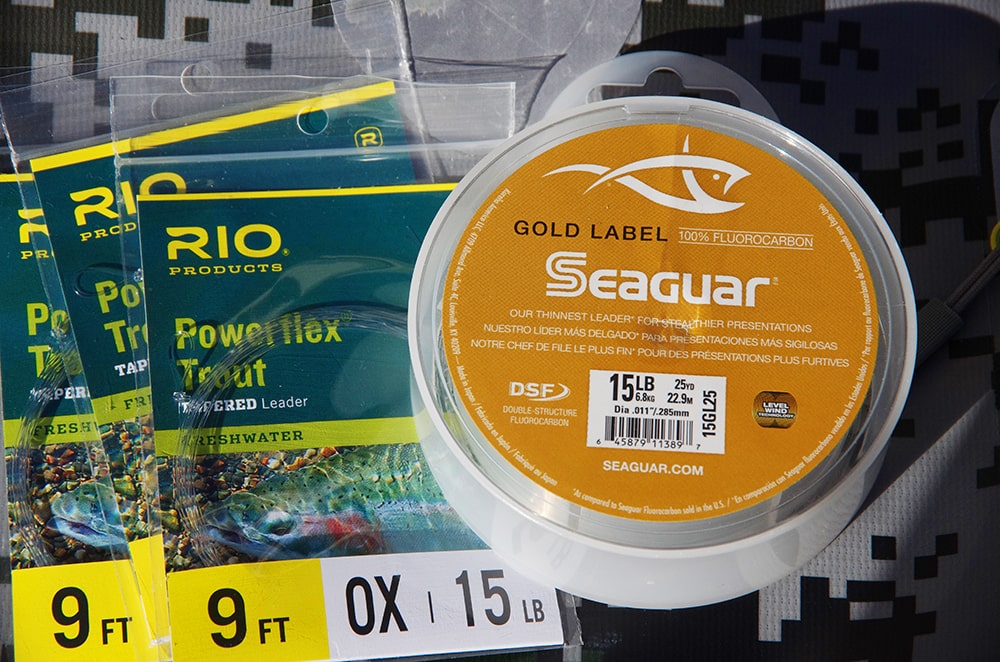
SMALLMOUTH BASS NET
I always carry a net with me because I lost the biggest smallmouth of my life at the boat. My net is fairly big, but you can use whatever you have. It’s better than nothing if you get a monster that you’d like to snap a few pictures of. It also makes it easier to keep the fish in the water while you position yourself for the photo.
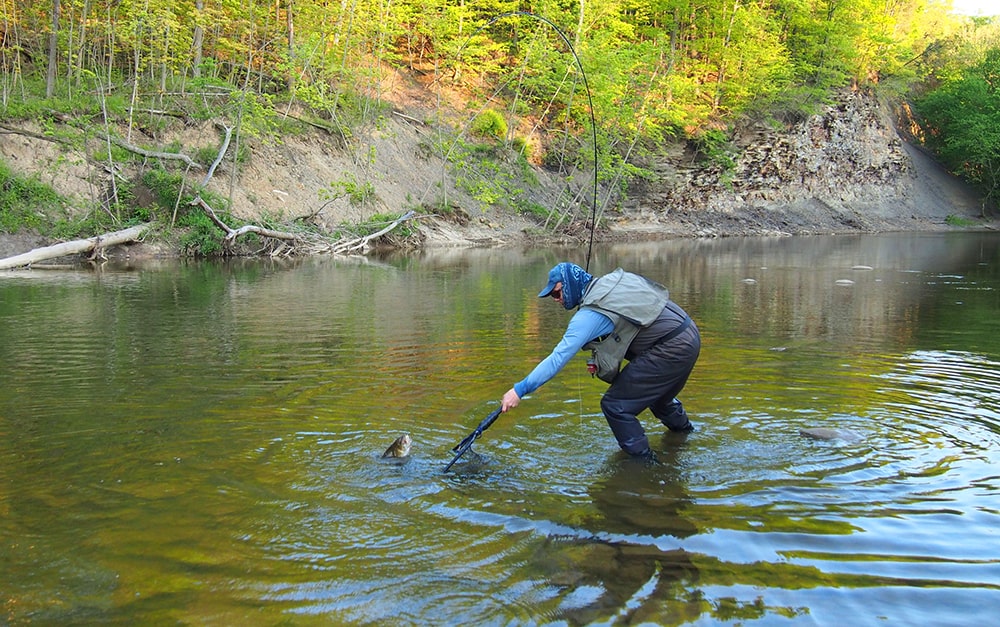
photo: Jeff Liskay
FINGER GUARD
There are plenty of other pieces of gear that you could use with smallmouth bass, but finger guards are one item that I always use when fishing for any species of fish where I am retrieving a fly. It can prevent line burns and can provide you a nice slot for stripping the line.
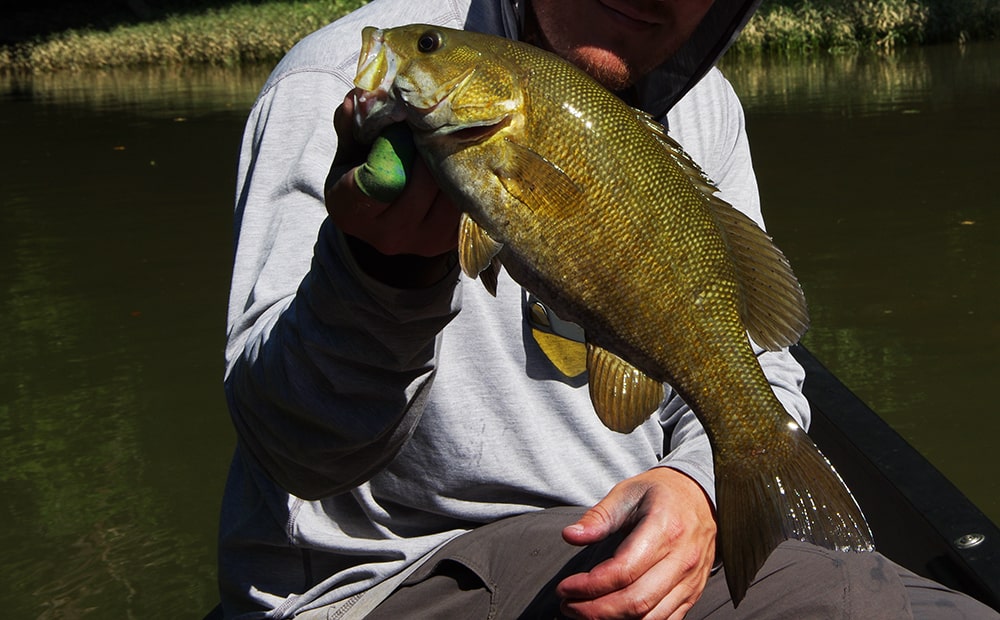
SMALLMOUTH BASS FLY FISHING PRESENTATIONS
Presentations for bass in general with conventional tackle are some of the most innovative and changing in the fishing industry. This is because of the many tournaments that involve both largemouth and smallmouth bass. If you expect simple techniques to be as effective as the ones used by the best tournament bass anglers, you’re wrong, plain and simple.
For this reason, we should continue to experiment with our fly fishing presentations for smallmouth bass. With this in mind, here are some standard fly fishing presentations you can use on smallmouth bass.
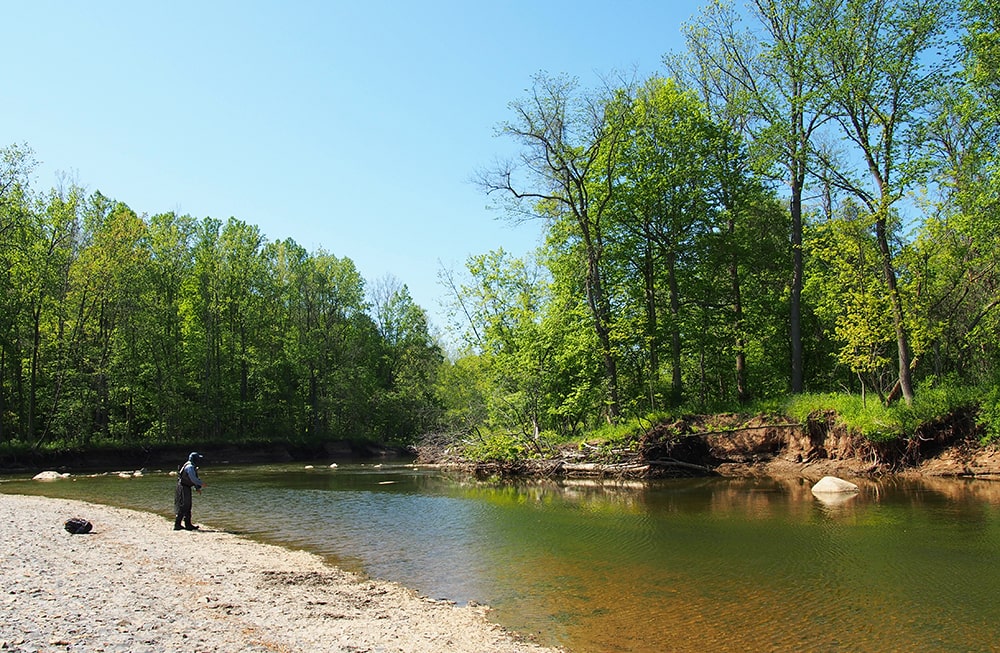
photo: Jeff Liskay
DEAD DRIFT
Dead drifting flies works for almost any species, no matter how predatory they are. If the fish are not as aggressive and/or the water temperature is low, you may have great success dead drifting flies. You can use an indicator and fish the fly near the bottom, or you can use a hovering fly and fish the fly up in the water column. You will out fish other fly anglers using this technique when the smallmouth are just not crushing moved flies.
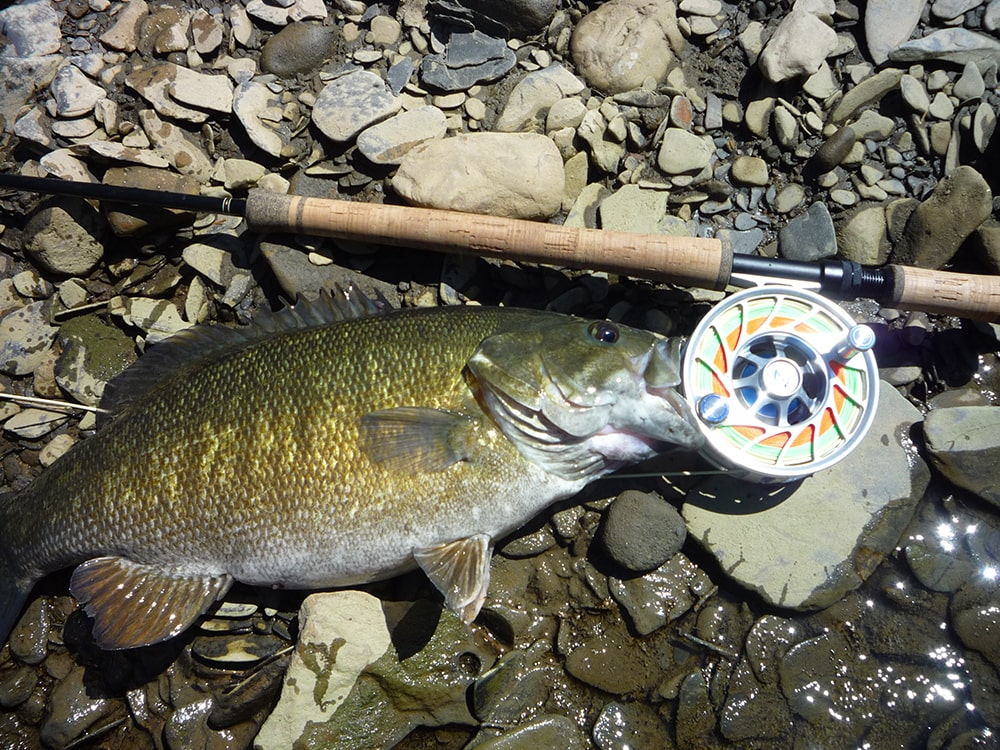
SMALLMOUTH TAKEN ON A DEAD-DRIFTED FLY
SLOW STEADY RETRIEVE
Again, when the fish are not supper aggressive, you can fish a slow long strip with the fly up in the water column or the fly right on or near the bottom. This is in places that don’t have as much current because otherwise the fly will swing. You can also do micro strips very slowly as well. The fly still moves steadily, but there are very short pauses.
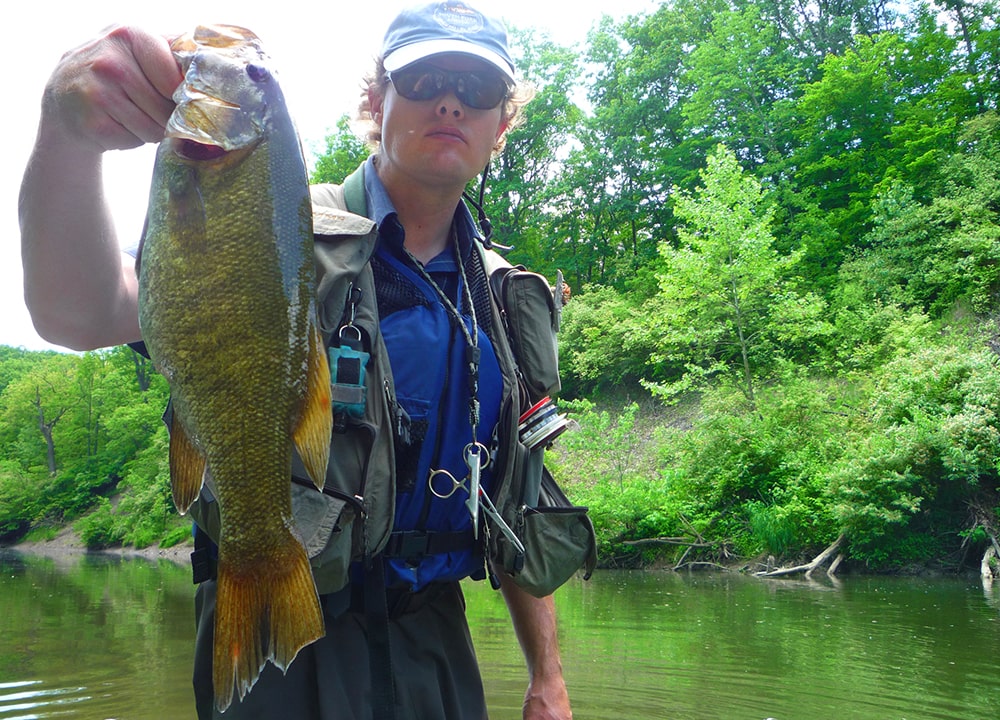
SWINGING
Swinging can work in smallmouth rivers as well. You can combine swinging and giving action to the fly to really increase your odds. You might swing a fly that you’re using for both smallmouth and steelhead. You also might not have a choice if fish are holding in the middle of a river. Your fly will swing across the current no matter the retrieve you use in this case.
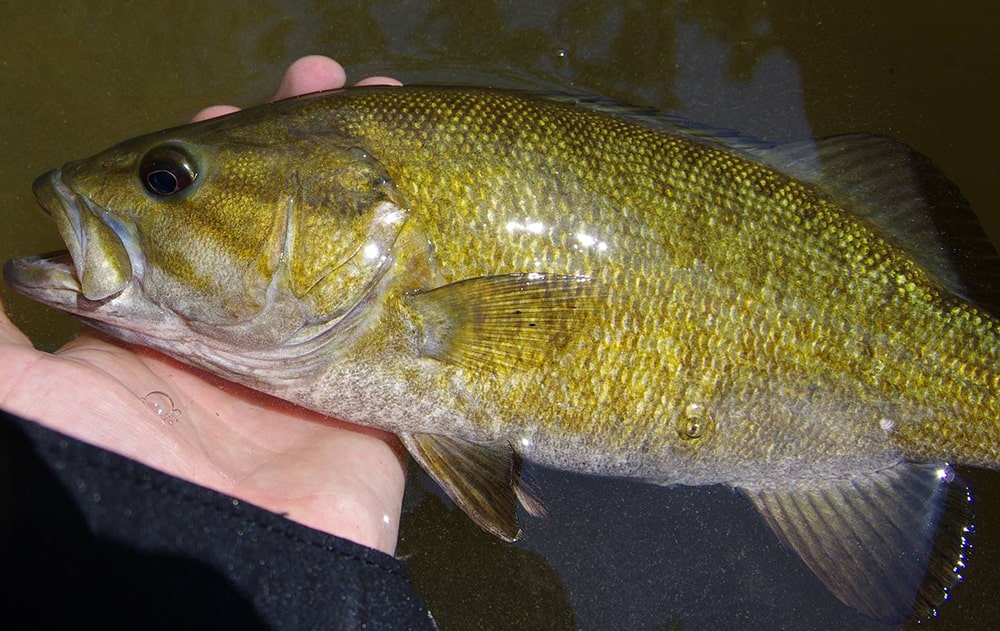
STRIP AND WAIT
Another technique for early season and a more finesse style presentations is the strip and wait. This can be done on the bottom, where you can use a fly like the Equalizer to strip and pop the fly up a foot or so and then wait for the fly to land back on the bottom. This same movement can be emulated in the upper water column as well. Normally you need to see the fly when fly fishing for smallmouth bass to detect the strike better. This retrieve can be used with topwater flies as well.
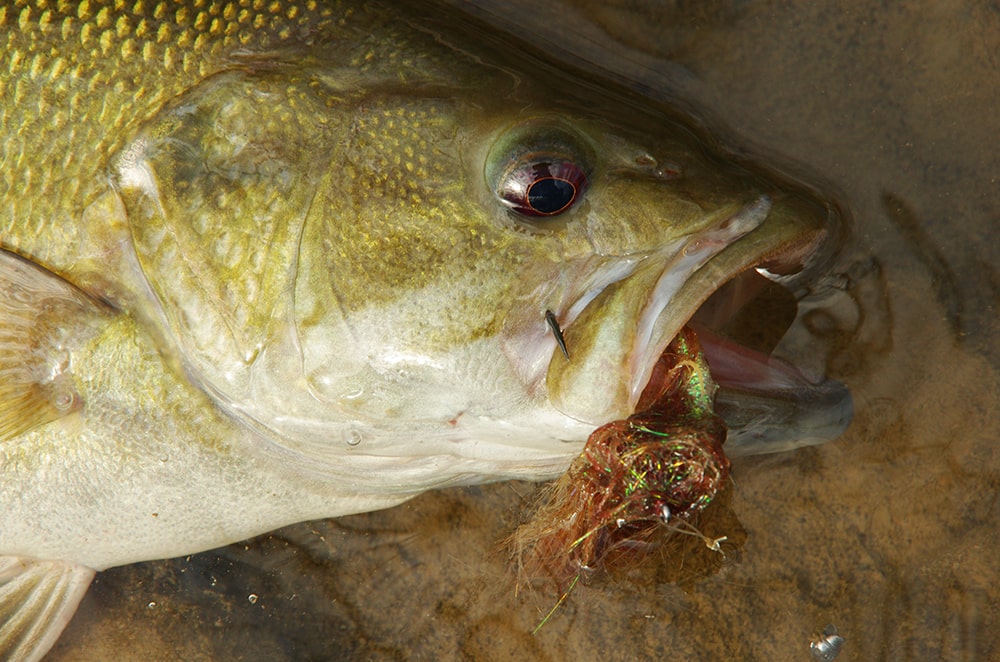
SIGHT-FISH JIGGLE
Sight fish jiggle is used when you are sight fishing to smallmouth bass. This is basically what you might do with bonefish or bedding bass, if you do that. You see a target and you tantalize the fish however you can. Normally, this requires letting the fly sit for a while as you vibrate the fly subtly. This technique can be used with topwater flies as well.
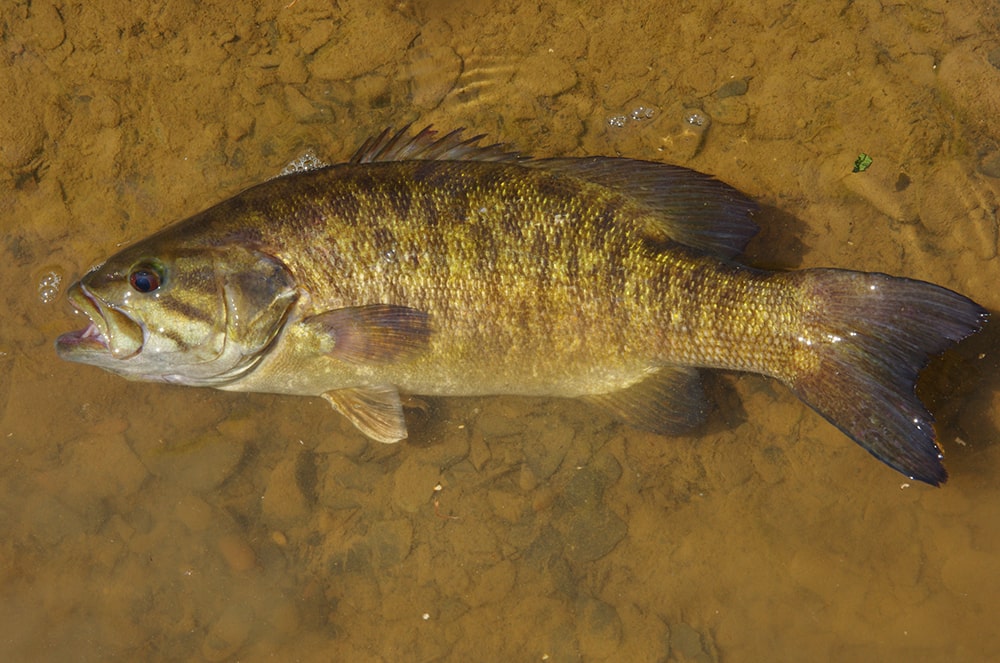
JIG RETRIEVE
This retrieve is used in general tackle for virtually every fish that swims. Fish are triggered into eating by certain sudden movements of prey. Jigging imitates this startled action for a continuous length of time, allowing you to increase your chances of hooking smallmouth.
It’s somewhat difficult to emulate this action with a fly rod because we use weighted fly lines that sink faster than the actual leader/tippet at times. This makes it difficult to jig the fly straight up and then allow it to fall back down.
The late Tim Holschlag emulated this action with his crayfish hop. This technique uses a floating line and an indicator. This keeps the line in a vertical position so the fly can jump up off the bottom and then sink back down.
Kelly Galloup uses a jerk strip to achieve a similar action as well. He uses the fly rod to pull the fly up/through the water and then takes up the excess line with his stripping hand. This can be done up in the water column and somewhat off of the bottom.
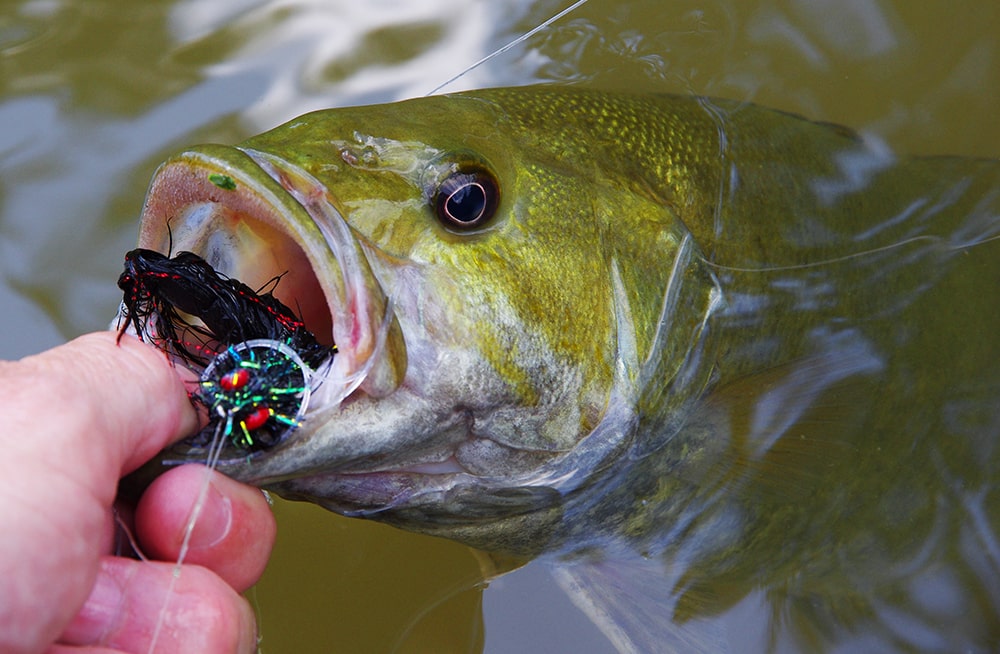
JERKBAIT RETRIEVE WITH PAUSES
The jerkbait retrieve is primarily achieved with flies that dart or glide and is very similar to the strip and wait style of retrieving. With a jerkbait style pattern, you make one strip, either moderate or long, but normally sharp. Then you wait long enough for the fly to move and possibly even sink/hover. Continue this stripping cadence until you find what the fish are on that day. Smallmouth bass love to hit on the pause, so seeing the fly is a great advantage at times.
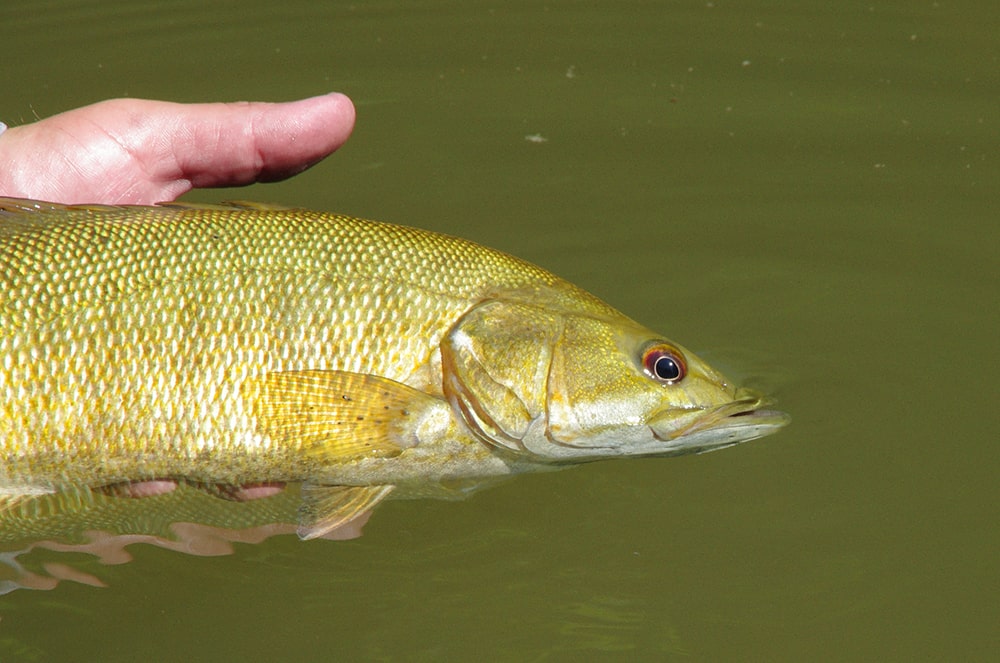
JERKBAIT RETRIEVE WITH FEW PAUSES
This retrieve is exactly like with pauses, but you pause very briefly if at all. This is a more aggressive retrieve that works a bit better as the water warms in the spring through the summer and into the fall until the water temp cools to such an extent that the smallmouth won’t take flies retrieved this fast.
This is also pretty much the cadence you want with flies that “walk the dog.” These topwater flies move back and forth in a zigzag movement. Many species of fish love this movement, and smallmouth will crunch these topwater patterns in warmer water in particular.
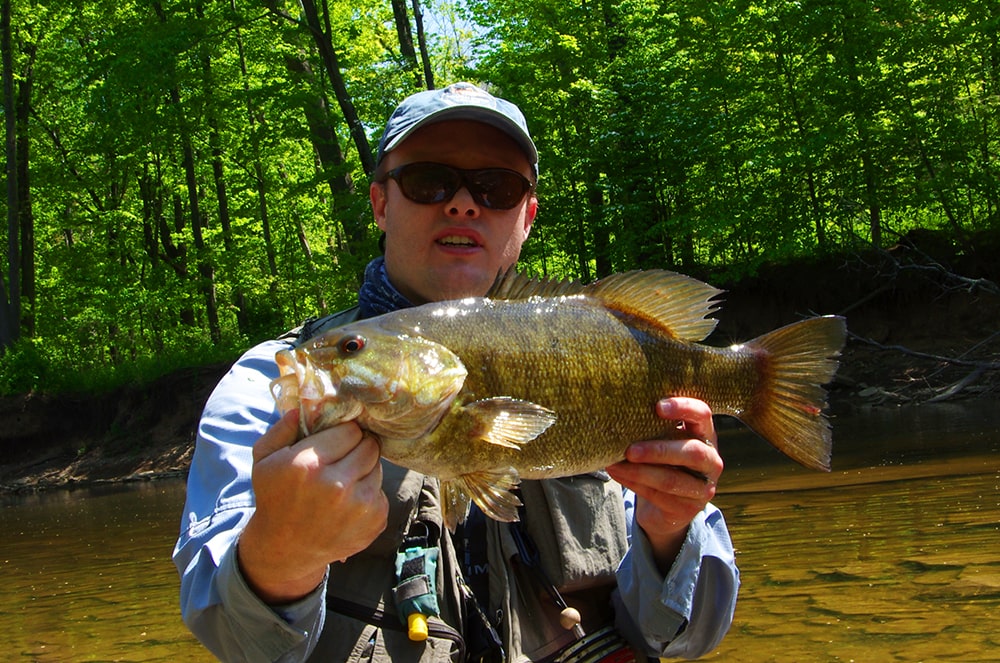
SNAP RETRIEVE
This retrieve is used with both horizontal and vertical-action flies. To do this retrieve, you make a long, quick snap of the fly line. With horizontal patterns, they move quickly with their horizontal action and then stop; then they repeat this movement.
With vertical action flies, the fly moves forward quickly in a straight line and then drops. This is similar to the jig action but is often more successful with active fish and is normally done up in the water column.
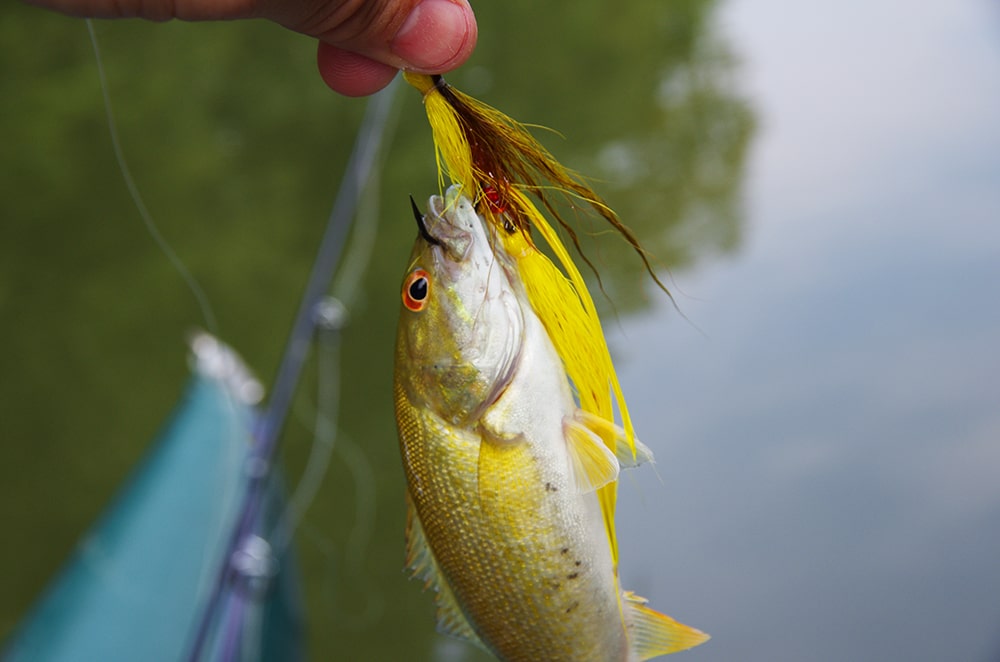
FAST STRIPPING
Fast stripping is simply that, fast movement of the fly through the water. Depending on the fly pattern, you’ll have normally less overall movement but fast movement forward. This speed is critical for some species, particularly in warmer water temperatures. I have found this action to be very effective in warmer early-fall situations in well oxygenated parts of rivers. I normally use horizontal-action patterns like the double deceiver to burn the fly through the water. This retrieve can be done with one or two hands.
You can also incorporate a sudden stop into the retrieve. This is particularly striking with a Game Changer as it burns and then will often make a sharp turn on the pause.
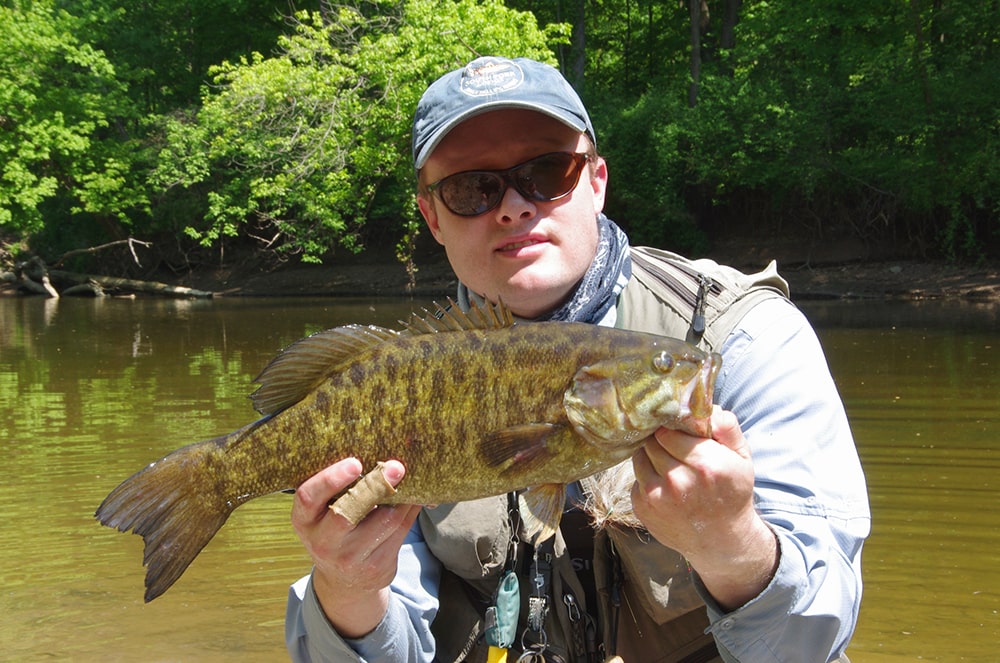
MIXED RETRIEVES
Finally, you can mix and match any and all of these retrieves together. This is a good technique when you’re trying to figure the fish out for the day. Note where in the water column you’re hooking fish, when they’re hitting, what speed, etc. Then you can begin to pattern the smallmouth using other flies and/or retrieves.
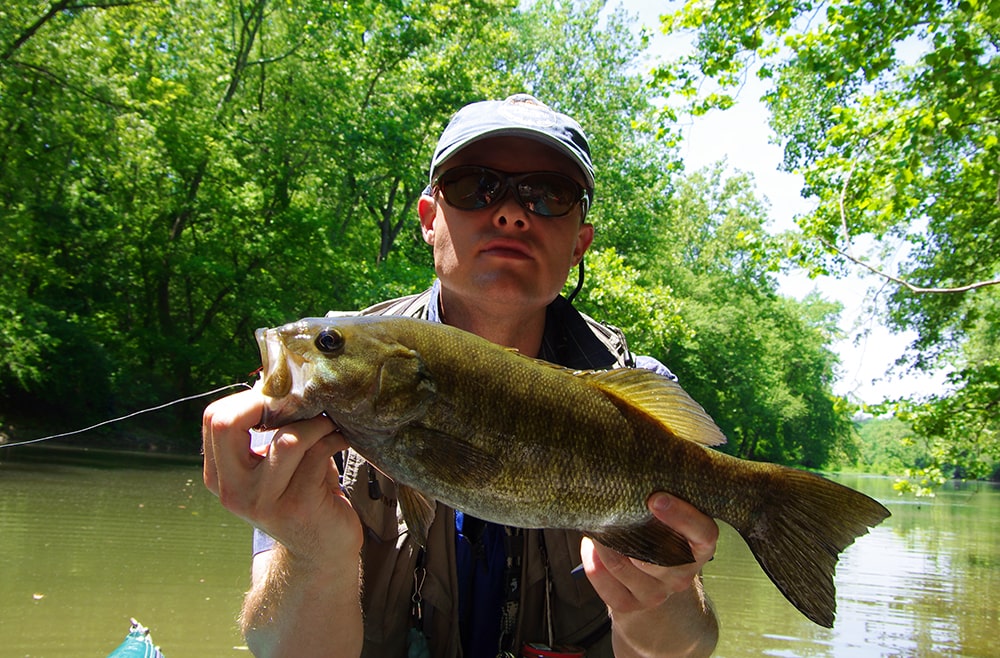
SOME TOP SMALLMOUTH BASS FLY FISHING DESTINATIONS
When one thinks about great trout waters in the United States, they think of the West. If you want the best smallmouth bass fisheries, you should look to the Great Lakes and Midwest. There are tremendous fisheries in other places or attached to the Mid-West, but these two destinations are filled to the brim with incredible smallmouth fisheries.
Here are some of the top states and provinces. Ontario, Minnesota, and Wisconsin are arguably the best smallmouth bass states in the country. They are all filled with huge smallmouth in thousands of different lakes and rivers.
North Dakota, Michigan, Virginia, Tennessee, and Manitoba have some excellent smallmouth bass fishing as well. States/provinces bordering on the Great Lakes/Lake St. Clair (Wisconsin, Michigan, Ohio, Pennsylvania, New York, and Ontario) offer you absurdly huge smallmouth bass in clear-water environments in addition to their states’ other great rivers and stillwaters.
In the West, Oregon, California, and Idaho have some solid smallmouth bass fishing, but much of the time trout are the primary species, or perhaps even largemouth bass in the case of California.
If you live in or around these states/provinces, you’ll more than likely be able to find some amazing smallmouth bass fly fishing opportunities.
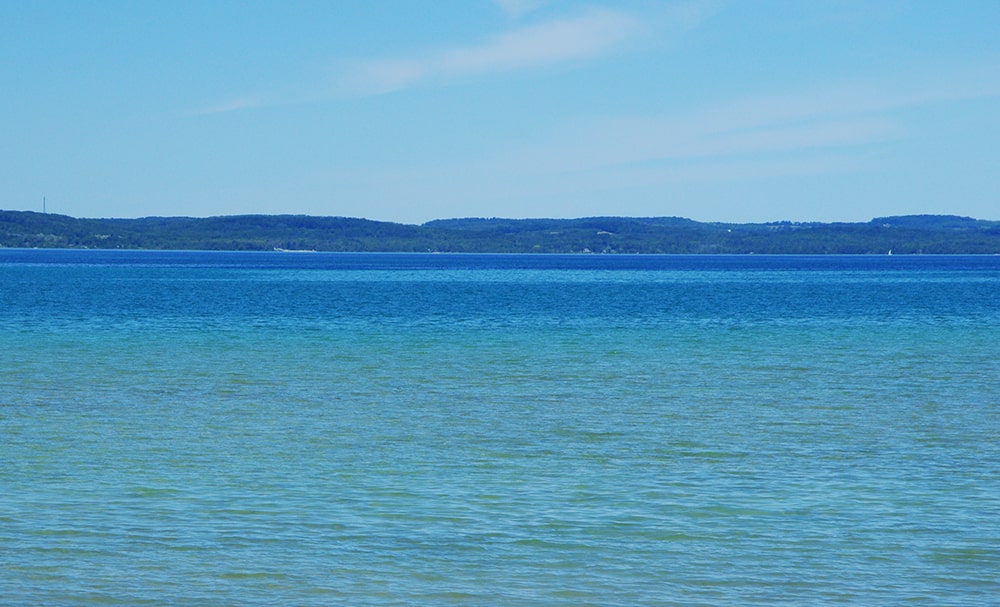
SMALLMOUTH BASS FLY FISHING IS BETTER THAN EVER
Smallmouth bass have expanded their range over most of North America. That means you can chase smallmouth bass almost anywhere on the continent. Smallmouth bass fly fishing techniques, gear, flies, and access to destinations are better than they’ve ever been. Conservation through habitat preservation and almost 100% catch and release has allowed huge numbers and sizes to be caught with relative frequency. There has never been a better time to fly fish for smallmouth bass!
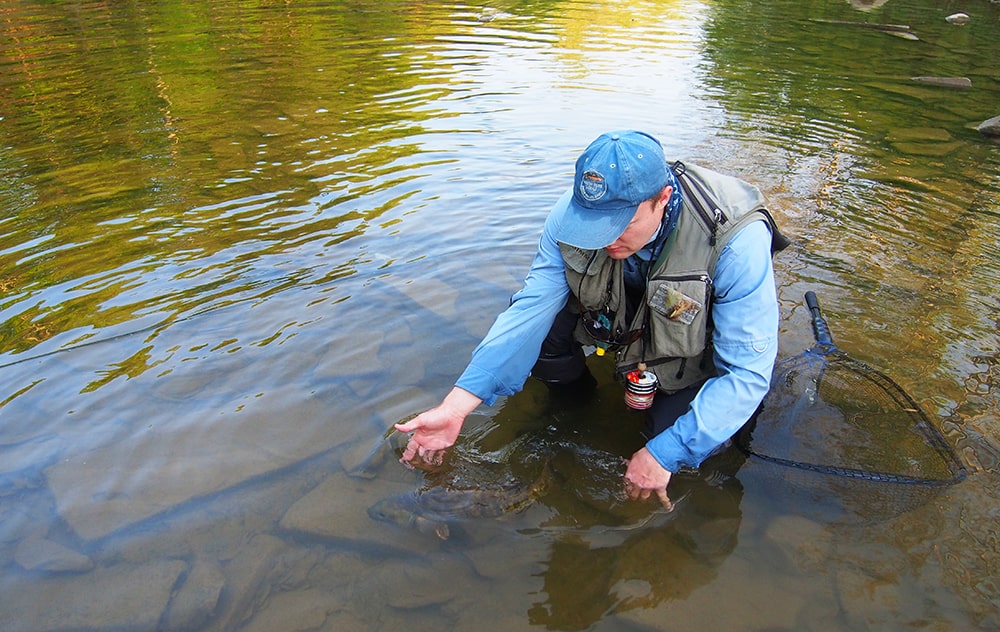
photo: Jeff Liskay

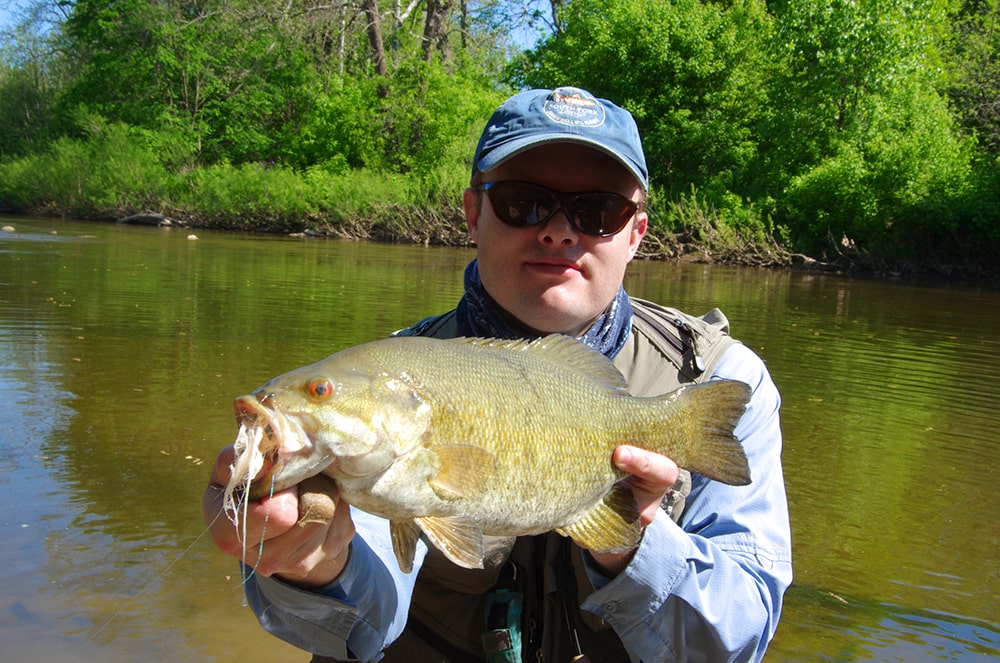

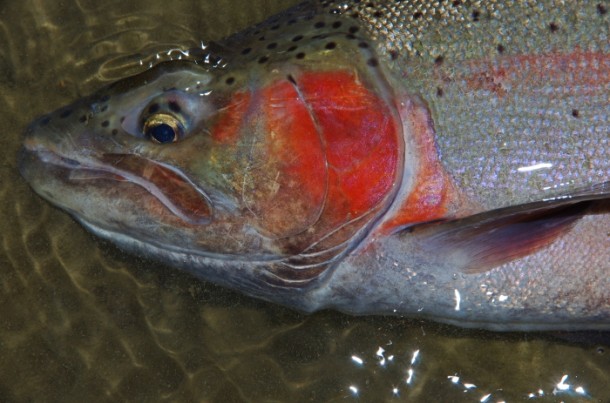
Great article. However I believe both New Hampshire and Maine offer world class smallmouth fishing opportunities too. Under fished in many areas, trout, landlocked salmon are the primary targets .
Hi Don,
Fair enough!
Hard to include everywhere, but you’re probably right about these states, and we could probably add Vermont as well.
I don’t have much experience in that neck of the woods, but I can believe that it’s got some great smallmouth fly fishing.
Thanks,
Justin